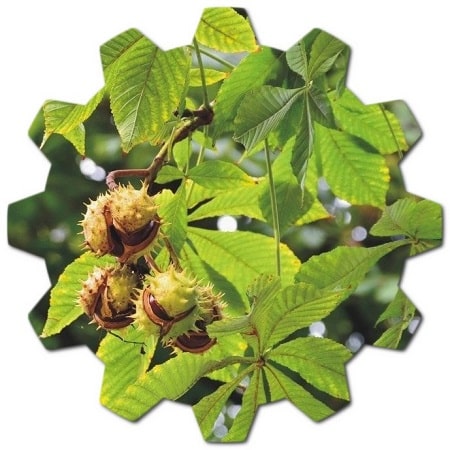What is Aesculus hippocastanum used for?
Aesculus Hippocastanum Leaf Extract (Horsechestnut) It is used in creams and shampoos to eliminate circulatory problems such as anti-inflammation, circulation acceleration, cellulite. It grows naturally in the Balkan peninsula. It is 20-25 m tall and the crown is 15-20 m wide. It is a round shaped, thick branched and coarse textured tree. The bark is reddish brown and cracked. Buds are very large, red brown. The leaves are opposite, radially arranged and 25 cm long, consisting of 5-7 leaflets. The upper side of the leaves is dark green.
In autumn they turn a vivid clear yellow to brown color. Flowers are spotted with white, yellow and red dots. Spike-shaped flower board is 20-30 cm long. It blooms in May. Fruits are 3-4 cm in diameter, fleshy, segmented, thick, spiny and short-stalked. Inside there are 1-2 seeds (chestnuts) with a shiny dark brown shell.
It grows well in temperate climates, in warm, sunny and semi-shady places; in normal, deep, fresh and semi-moist loamy soils. Deeply rooted. It is a good soil holder. It grows well even in stony, rocky places. It is a very good park and road tree. Creates dark shade. It is very impressive with its symmetrical form when used as a solitary. It cannot grow well in compacted soils. It is also negatively affected by molten salts. It is an important food source for bees. It is a very good massing, park, shading and allee tree. Due to its coarse texture, it should be used away from closed spaces.
Is Aesculus hippocastanum safe?
Aesculus hippocastanum, commonly known as Horse Chestnut, has several traditional and historical uses, but its practical applications are somewhat limited due to the toxicity of its seeds and the fact that it’s primarily planted for ornamental purposes in modern times. Here are some of its historical and traditional uses:

- Traditional Medicine: Various parts of the horse chestnut tree, including the bark, leaves, and seeds, have been used in traditional herbal medicine in the past. Extracts from the seeds and bark contain compounds called aesculin and aescin, which were believed to have medicinal properties. They were used to treat conditions like varicose veins, hemorrhoids, and edema (fluid retention). However, these uses are not widely recommended today, and alternative treatments are preferred.
- Horse Chestnuts (Conkers): The seeds, commonly known as conkers, are used in children’s games, most notably the game of conkers, where children try to break each other’s conkers by striking them with another conker attached to a string. This traditional game is popular in the UK and other regions.
- Woodworking: The wood of the horse chestnut tree is not highly valued for its timber, as it tends to be relatively soft and not as durable as other hardwoods. However, it has been used for small woodworking projects, carvings, and ornamental items.
- Ornamental Plant: In modern times, Aesculus hippocastanum is mainly cultivated and planted for ornamental purposes. Its large, attractive leaves and pyramid-shaped clusters of flowers make it a beautiful addition to parks, gardens, and streetscapes. It provides shade and visual interest in urban and suburban landscapes.
- Wildlife and Ecology: Horse chestnut trees provide habitat and food for various wildlife species. The nectar-rich flowers attract pollinators like bees, and the seeds may be consumed by some birds and small mammals, although they are not a primary food source due to their toxicity.
It’s important to note that while horse chestnut has been used in traditional medicine, its internal use is discouraged due to the presence of aesculin, which can be toxic if consumed in significant quantities. Ingesting conkers or extracts from horse chestnut seeds can lead to poisoning symptoms, including nausea, vomiting, and, in severe cases, more serious effects on the digestive and nervous systems. Therefore, any traditional or historical medicinal uses of horse chestnut should be approached with caution, and it is advisable to consult with a healthcare professional for safe and effective treatments for specific medical conditions.
Where does Aesculus hippocastanum grow?
Aesculus hippocastanum, commonly known as Horse Chestnut, is native to southeastern Europe, specifically the Balkan Peninsula. It is indigenous to regions of Albania, Bulgaria, Greece, and the western part of the former Yugoslavia.

However, due to its attractive appearance and ornamental value, the Horse Chestnut has been widely cultivated and planted in various parts of the world. It is commonly found in parks, gardens, and along streets in Europe, North America, and other temperate regions. It is appreciated for its aesthetic qualities, including its large, palmate leaves and showy pyramid-shaped clusters of white to pinkish-white flowers.
In cultivation, Horse Chestnuts typically thrive in temperate climates with well-drained soil and moderate moisture. They are often used for ornamental purposes, providing shade and beauty to urban and suburban landscapes. The tree’s adaptability to a range of soil types and its tolerance of urban pollution make it a popular choice for urban tree planting in some areas.





